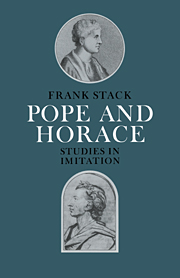Book contents
- Frontmatter
- Contents
- Acknowledgements
- List of abbreviations
- Preface
- PART I INTRODUCTIONS
- PART II THREE HORATIAN SATIRES (1733–4)
- PART III MATURE HORACE (1736–7)
- 6 Lyric vision: The Imitations of Odes IV.i. and IV.ix.
- 7 The Horatian epistle: The Imitation of Epistle II.ii.
- 8 Poetry and politics: The Imitation of Epistle II.i. (‘To Augustus’)
- PART IV THE TIME OF TENSION (1738)
- Epilogue
- Appendix: Imitations of Horace published 1730–40
- Notes
- Bibliography
- Index
7 - The Horatian epistle: The Imitation of Epistle II.ii.
Published online by Cambridge University Press: 08 January 2010
- Frontmatter
- Contents
- Acknowledgements
- List of abbreviations
- Preface
- PART I INTRODUCTIONS
- PART II THREE HORATIAN SATIRES (1733–4)
- PART III MATURE HORACE (1736–7)
- 6 Lyric vision: The Imitations of Odes IV.i. and IV.ix.
- 7 The Horatian epistle: The Imitation of Epistle II.ii.
- 8 Poetry and politics: The Imitation of Epistle II.i. (‘To Augustus’)
- PART IV THE TIME OF TENSION (1738)
- Epilogue
- Appendix: Imitations of Horace published 1730–40
- Notes
- Bibliography
- Index
Summary
The most melancholy effect of years is that you mention, the catalogue of those we lov'd and have lost, perpetually increasing.
Pope to Swift, 30 December 1736Horace'sEpistle II.ii., addressed to Julius Florus, is one of Horace's most beautifully finished and richest verse epistles. Like its companion piece, Epistle II.i. to Augustus, the poem is notable for the complexity and subtlety of its form, the fine interweaving of its various themes, and the calm maturity of its completed poetic vision. Both are concerned with the art of poetry; but that to Augustus, appropriately, treats the subject in public manner, raising questions about culture, taste, and the public role of the poet, while this poem is personal and inward, concerned with Horace and his own life. And yet it has wider perspectives: at once private and universal, it brings together, and distinguishes between, the demands of poetry which concern the artist and the demands of life which affect everyone.
In approaching these two epistles we must realize that they raise new and difficult questions about form and meaning. Whereas the early satires, like Satire I.ii. and Satire II.ii., are relatively simple in design, these late epistles are highly elusive. Indeed, it is difficult to speak of either the ‘subject’ or the ‘form’ of a delicately orchestrated work like Epistle II.ii.: both can be discussed only in relation to the experience of reading, for in the mature Horatian epistle subjects and form emerge only in the created time of imaginative involvement. These epistles have been given the shape of casual conversation: they are purposeful, but they seem to have no purpose.
- Type
- Chapter
- Information
- Pope and HoraceStudies in Imitation, pp. 116 - 149Publisher: Cambridge University PressPrint publication year: 1985

